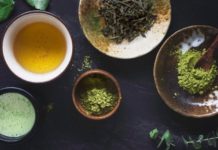
Over his lifetime, the average man spends 9,000 hours shaving. Shaving creme and aftershave were designed to make the process easier and more pleasurable, but conventional products may be doing more harm than good.
Over his lifetime, the average man spends 9,000 hours shaving. Shaving creme and aftershave were designed to make the process easier and more pleasurable, but conventional products may be doing more harm than good.
Picture this. You and your partner are ready for a night on the town. You’ve used natural skin care products and your complexion is soft and glowing. He’s lathered his face with conventional shaving creme and splashed his tender skin with aftershave loaded with unpronounceable ingredients. His newly shaven mug is dry and irritated; red spots dot his jaw line and cluster under his chin. His scent is so strong, your eyes water.
You’ve tried to direct your mate to natural products, but he prefers the old standbys. It’s time to revolutionize his grooming habits.
Reasons to Change
Because men’s grooming products are applied to skin that is abraded during shaving–the closer the shave, the more the abrasion–their ingredients are readily absorbed. Once in the bloodstream, they are carried throughout the body to various organs, including the brain, liver, and kidneys.
Some researchers believe adverse reactions such as dermatitis, skin dryness, photosensitivity, and irritation of the eyes and upper respiratory tract are only a few of the consequences of using conventional grooming products. Consumer advocates assert some cosmetic ingredients are carcinogenic or affect the nervous and reproductive systems.
Currently, Health Canada believes the chemical concentration in cosmetic products is too low to cause cancer. However, most research into the health effects of grooming aids focuses on short-term skin sensitivity rather than long-term systemic risks from the cumulative effects of daily exposure. In addition, the majority of these ingredients have not been evaluated for safety–alone or in combination–by government or other public institutions.
Fragrance-Free
Synthetic fragrances found in most men’s grooming products are a major concern as they cause about 30 percent of all adverse reactions. A single fragrance may contain 100 chemicals, many of which have been identified as toxic substances. By law, cosmetic labels must list all ingredients; however, fragrances are exempt because their ingredients are considered trade secrets.
Conventional manufacturers also use a host of chemicals that act as penetration enhancers, emulsifiers, disinfectants, and preservatives. Other ingredients add body to foams and gels, keep products from melting or freezing in extreme temperatures, or make the product more visually appealing.
Healthier Alternatives
There is life beyond conventional shaving cremes and aftershaves. More and more natural alternatives that are free from synthetic fragrances, colours, or petroleum products are being marketed today. Check out your local health or natural food stores.
When shopping, beware of greenwashing buzzwords such as “natural,” “green,” and “botanical” that make chemical-laden cosmetic products sound healthier. Become a knowledgeable shopper by always checking the label. Visit manufacturers’ websites to learn more about their product ingredients and manufacturing practices and policies. Companies that produce truly healthy products openly offer consumer information.
Back to your partner and his poor, abused face. Talk to him about healthier shaving products. Show him this article. Give him a tour of the men’s grooming section of your natural food store. Or buy him a natural product, dare him to use it for a month, and let his face decide.
Remember, good health is more than skin deep.
Ingredients to Look for
- aloe vera
- botanical resins
- essential oils
- herbal extracts
- honey
- lecithin
- locust bean gum, guar gum, acacia gum
- soy protein
- witch hazel
Ingredients to Avoid
- 1,3-Dimethylol-5,5-dimethyl (DMDM) hydantoin
- butylated hydroxytoluene
- cocamide or lauramide diethanolamine (DEA)
- diazolidinyl urea
- food, drug, and cosmetic (FD&C) colours
- formaldehyde
- propylene glycol
- sodium laureth or sodium lauryl sulphate
- triethanolamine (TEA)















